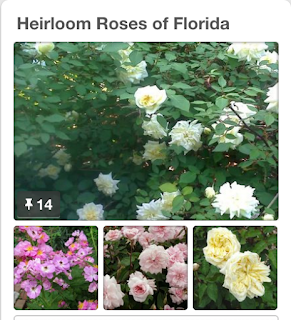 |
| I've started a Pinterest board of the roses mentioned in an 1892 Florida newspaper gardening column. Visit the board on my Pinterest page. |
Roses aren't the easiest flowers to grow in Florida, but that doesn't stop any of us from trying. Through trial, error, education, and a fondness for heirloom varieties with scented flowers, I've learned that the China, Tea, and Noisette classifications are the best old-style types for Florida.
These are also the ones pioneer Floridians relied on. But there are thousands of varieties within these classes. It's a challenge to learn what the frontier rose aficionado grew after watching Northern-grown imports languish. A treasure chest opened for me the day I read the many varieties named in a Jan. 20, 1892, garden column in the Florida Agriculturist newspaper.
Local lore has long crowned Louis Philippe as the Florida Cracker rose. I can attest to its perfection. Two plants I dug from a friend's yard lived for years in mine, until I transplanted them one too many times. Another word-of-mouth favorite is the yellow climber Marechal Niel. When I finally tracked down a specimen, it died soon after transplanting. Modern strains of this beautiful rose are believed to be weakened by a virus.
Both these varieties are named in the Florida Agriculturist Floral Department column by R.B. or R.H. Burr, whom I haven't yet identified. The first two initials are fuzzy and hard to read. The writer gave a rose named Agrippina equal status with Louis Philippe:
That was the first time I've ever heard of Agrippina. A Google Images search turned up a flower that looks much like Louis Philippe, only with a deeper crimson color. No word on its scent. Louis Philippe has a fruity-spicy aroma that's part of its charm.
Louis Philippe rose from my garden. "Agrippina and Louis Philipe [sic] are both excellent ... fair growers and profuse bloomers. They cannot be dispensed with."
Mr. or Ms. Burr's list was lengthy and apparently based on his/her personal Florida garden experiences. Most of the varieties are unfamiliar to me, and Old Blush - another favorite that did beautifully for me until I tried to transplant its 6-foot-tall mass - isn't even included.
A partial list of Burr's is below, with additional information added by me after referencing Best Rose Guide by Roger Phillips and Martyn Rix. Those notes are prefaced by the letters BRG and a page number.
- Bon Silene: fair grower, constant bloomer, spicy fragrance, single flower. BRR, 91: color varies from bright pink with deep yellow in center to crimson; sweet fruity scent.
- Madam Berard: half climber, vigorous growth on own roots, "... in favorable weather produces buds as near perfection as a lack of fragrance will admit."
- Caroline Kuster: fairly good bloomer. "Good rose of its color which is much lighter than that of Isabella Sprunt."
- La Sulphide: good grower. "Buds are superb in favorable weather but have little odor."
- Madam Alfred Carriere: vigorous grower on own roots, constant bloomer. BRG, 103: white with flush of warm in center; Noisette rose.
- Queen of Bedders: poor grower but a profuse bloomer. BRG, 117: double flowers, excellent scent; Bourbon rose.
- Red Malmaison: "Doesn’t come up to expectations, too poor a grower to lose time with."
- Madam Caro: strong grower, constant bloomer, flowers large.
- Perle des Jardins and Coquette de Lyon: Burr found these two very similar, and advised gardeners to instead choose Isabella Sprunt and Marechal Neil.
- Agrippina and Louis Philipe: both excellent, fair growers, profuse bloomers. " (Burr spelled Philippe with one p.)
- Empress Eugenie: strong grower, flowers beautifully formed.
- Duchess de Brabant: good grower, constant bloomer, good rose of its class. Burr expressed a preference for Madame Caro. BRG, 98: nodding flowers of salmon or shrimp pink. Duchess de Brabant is a secondary name of a rose identified as Comtesse de Labarthe.
I'm still deciphering spelling and names on the Burr roses not included here; I'll try to write about them in the future. In Part 2 of this blog post, we'll look at how pioneers used roses. Right now, I'm going out to smell the roses of my Bermuda Spice shrub, which I learned in BRG was rediscovered in Bermuda after dying out in Europe, where it was known as Hume's Blush Tea-Scented China. You gotta love the detective work!


No comments:
Post a Comment